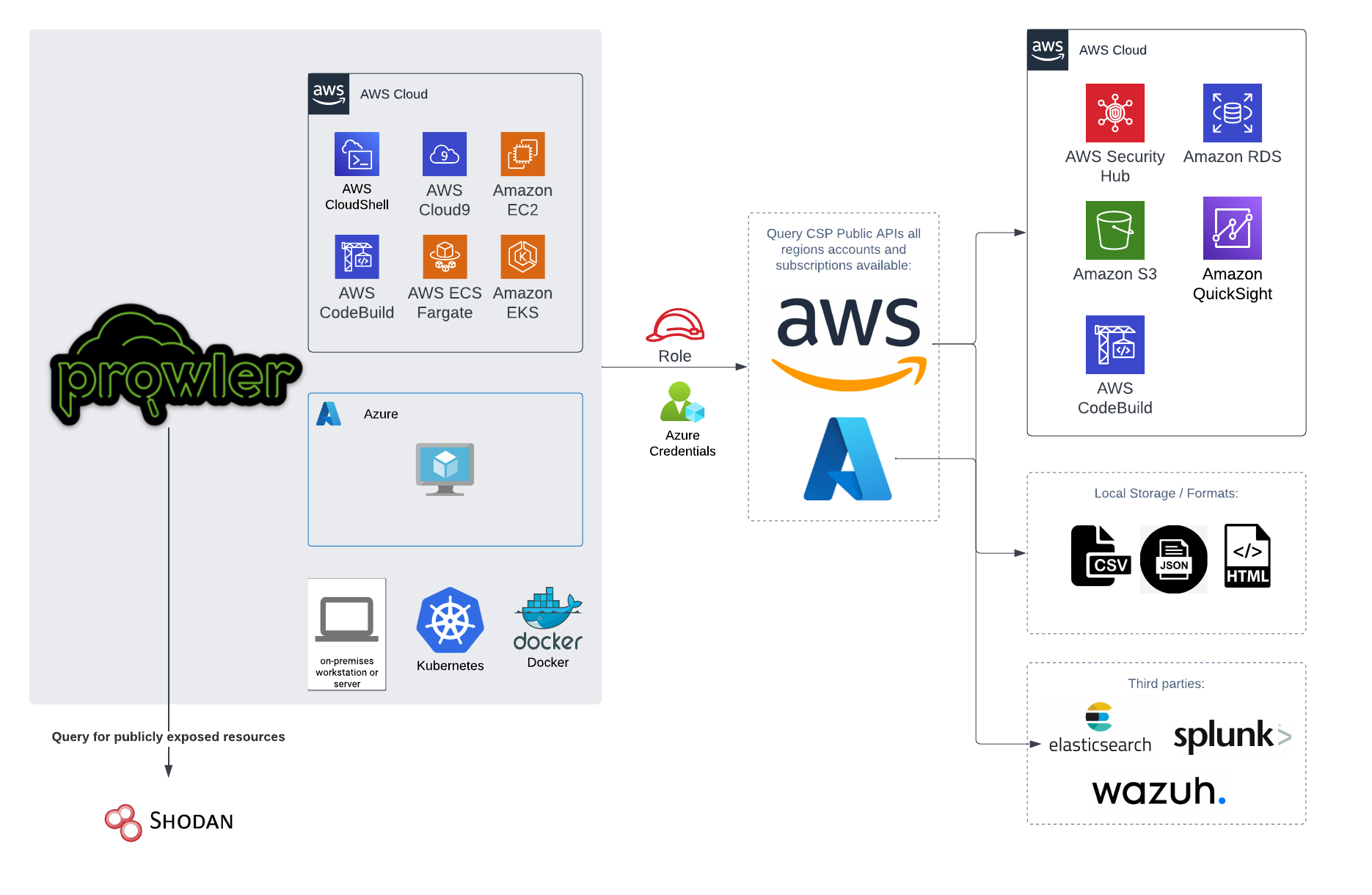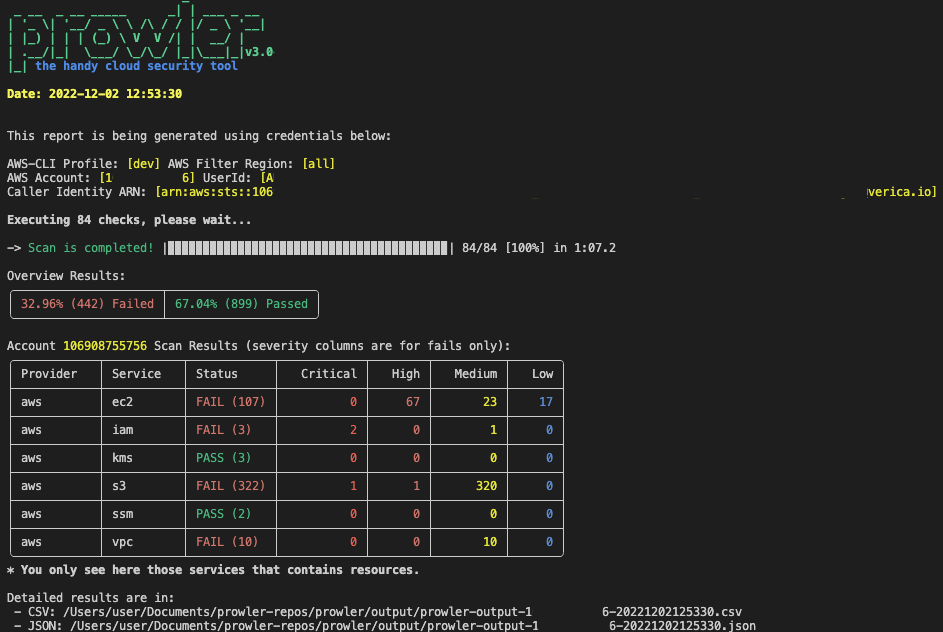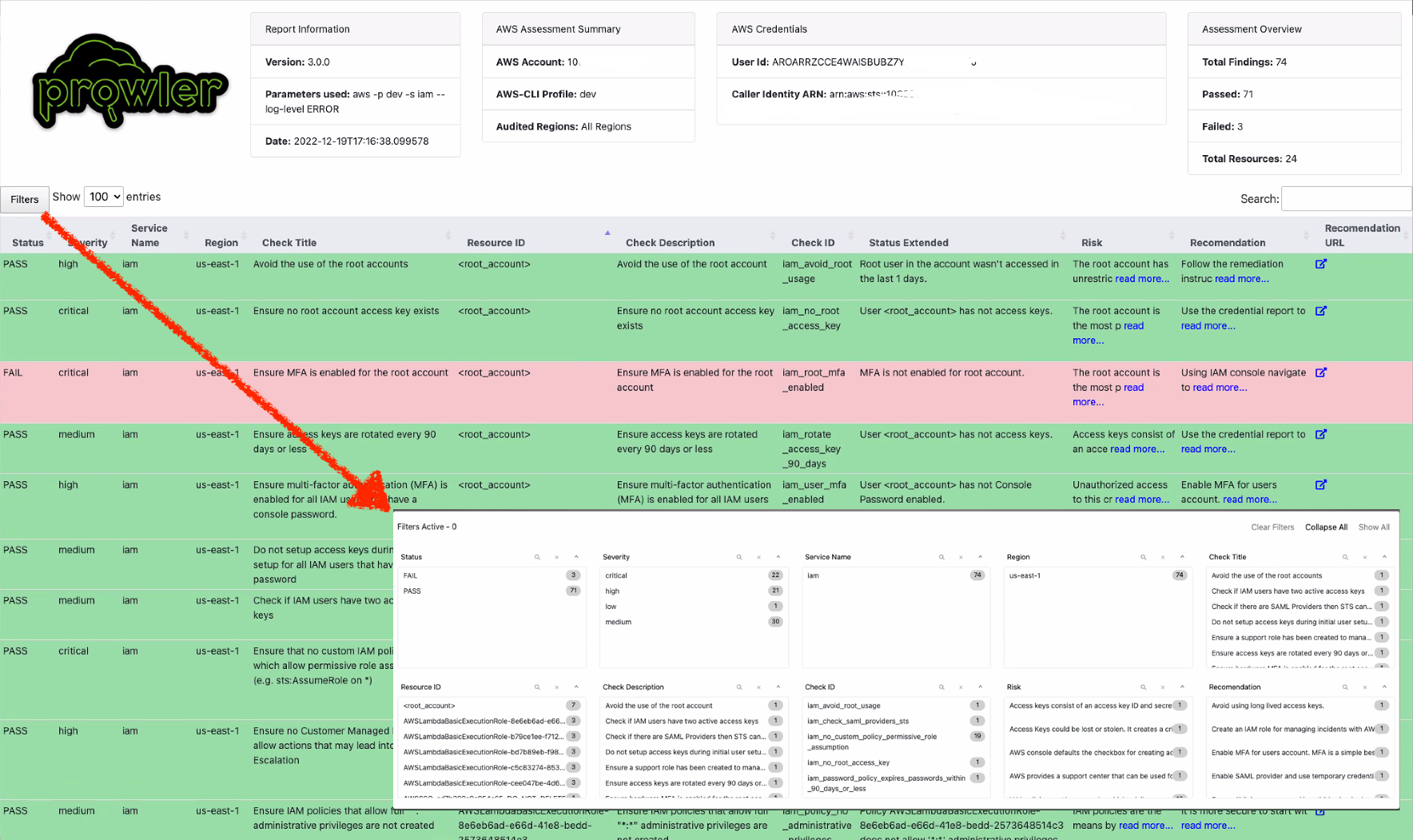Prowler is an Open Source security tool to perform Cloud Security best practices assessments, audits, incident response, continuous monitoring, hardening and forensics readiness. It contains more than 240 controls covering CIS, PCI-DSS, ISO27001, GDPR, HIPAA, FFIEC, SOC2, AWS FTR, ENS and custom security frameworks.
Project description

See all the things you and your team can do with ProwlerPro at prowler.pro

Description
Prowler is an Open Source security tool to perform AWS and Azure security best practices assessments, audits, incident response, continuous monitoring, hardening and forensics readiness.
It contains hundreds of controls covering CIS, PCI-DSS, ISO27001, GDPR, HIPAA, FFIEC, SOC2, AWS FTR, ENS and custom security frameworks.
📖 Documentation
The full documentation can now be found at https://docs.prowler.cloud
Looking for Prowler v2 documentation?
For Prowler v2 Documentation, please go to https://github.com/prowler-cloud/prowler/tree/2.12.1.
⚙️ Install
Pip package
Prowler is available as a project in PyPI, thus can be installed using pip with Python >= 3.9:
pip install prowler
prowler -v
More details at https://docs.prowler.cloud
Containers
The available versions of Prowler are the following:
latest: in sync with master branch (bear in mind that it is not a stable version)<x.y.z>(release): you can find the releases here, those are stable releases.stable: this tag always point to the latest release.
The container images are available here:
From Github
Python >= 3.9 is required with pip and poetry:
git clone https://github.com/prowler-cloud/prowler
cd prowler
poetry shell
poetry install
python prowler.py -v
📐✏️ High level architecture
You can run Prowler from your workstation, an EC2 instance, Fargate or any other container, Codebuild, CloudShell and Cloud9.
📝 Requirements
Prowler has been written in Python using the AWS SDK (Boto3) and Azure SDK.
AWS
Since Prowler uses AWS Credentials under the hood, you can follow any authentication method as described here. Make sure you have properly configured your AWS-CLI with a valid Access Key and Region or declare AWS variables properly (or instance profile/role):
aws configure
or
export AWS_ACCESS_KEY_ID="ASXXXXXXX"
export AWS_SECRET_ACCESS_KEY="XXXXXXXXX"
export AWS_SESSION_TOKEN="XXXXXXXXX"
Those credentials must be associated to a user or role with proper permissions to do all checks. To make sure, add the following AWS managed policies to the user or role being used:
- arn:aws:iam::aws:policy/SecurityAudit
- arn:aws:iam::aws:policy/job-function/ViewOnlyAccess
Moreover, some read-only additional permissions are needed for several checks, make sure you attach also the custom policy prowler-additions-policy.json to the role you are using.
If you want Prowler to send findings to AWS Security Hub, make sure you also attach the custom policy prowler-security-hub.json.
Azure
Prowler for Azure supports the following authentication types:
- Service principal authentication by environment variables (Enterprise Application)
- Current az cli credentials stored
- Interactive browser authentication
- Managed identity authentication
Service Principal authentication
To allow Prowler assume the service principal identity to start the scan, it is needed to configure the following environment variables:
export AZURE_CLIENT_ID="XXXXXXXXX"
export AZURE_TENANT_ID="XXXXXXXXX"
export AZURE_CLIENT_SECRET="XXXXXXX"
If you try to execute Prowler with the --sp-env-auth flag and those variables are empty or not exported, the execution is going to fail.
AZ CLI / Browser / Managed Identity authentication
The other three cases do not need additional configuration, --az-cli-auth and --managed-identity-auth are automated options, --browser-auth needs the user to authenticate using the default browser to start the scan.
Permissions
To use each one, you need to pass the proper flag to the execution. Prowler for Azure handles two types of permission scopes, which are:
- Azure Active Directory permissions: Used to retrieve metadata from the identity assumed by Prowler and future AAD checks (not mandatory to have access to execute the tool)
- Subscription scope permissions: Required to launch the checks against your resources, mandatory to launch the tool.
Azure Active Directory scope
Azure Active Directory (AAD) permissions required by the tool are the following:
Directory.Read.AllPolicy.Read.All
Subscriptions scope
Regarding the subscription scope, Prowler by default scans all the subscriptions that is able to list, so it is required to add the following RBAC builtin roles per subscription to the entity that is going to be assumed by the tool:
Security ReaderReader
💻 Basic Usage
To run prowler, you will need to specify the provider (e.g aws or azure):
prowler <provider>
Running the
prowlercommand without options will use your environment variable credentials.
By default, prowler will generate a CSV, a JSON and a HTML report, however you can generate JSON-ASFF (only for AWS Security Hub) report with -M or --output-modes:
prowler <provider> -M csv json json-asff html
The html report will be located in the output directory as the other files and it will look like:
You can use -l/--list-checks or --list-services to list all available checks or services within the provider.
prowler <provider> --list-checks
prowler <provider> --list-services
For executing specific checks or services you can use options -c/--checks or -s/--services:
prowler aws --checks s3_bucket_public_access
prowler aws --services s3 ec2
Also, checks and services can be excluded with options -e/--excluded-checks or --excluded-services:
prowler aws --excluded-checks s3_bucket_public_access
prowler aws --excluded-services s3 ec2
You can always use -h/--help to access to the usage information and all the possible options:
prowler -h
Checks Configurations
Several Prowler's checks have user configurable variables that can be modified in a common configuration file. This file can be found in the following path:
prowler/config/config.yaml
AWS
Use a custom AWS profile with -p/--profile and/or AWS regions which you want to audit with -f/--filter-region:
prowler aws --profile custom-profile -f us-east-1 eu-south-2
By default,
prowlerwill scan all AWS regions.
Azure
With Azure you need to specify which auth method is going to be used:
prowler azure [--sp-env-auth, --az-cli-auth, --browser-auth, --managed-identity-auth]
By default,
prowlerwill scan all Azure subscriptions.
🎉 New Features
- Python: we got rid of all bash and it is now all in Python.
- Faster: huge performance improvements (same account from 2.5 hours to 4 minutes).
- Developers and community: we have made it easier to contribute with new checks and new compliance frameworks. We also included unit tests.
- Multi-cloud: in addition to AWS, we have added Azure, we plan to include GCP and OCI soon, let us know if you want to contribute!
📃 License
Prowler is licensed as Apache License 2.0 as specified in each file. You may obtain a copy of the License at http://www.apache.org/licenses/LICENSE-2.0
Project details
Release history Release notifications | RSS feed
Download files
Download the file for your platform. If you're not sure which to choose, learn more about installing packages.
Source Distribution
Built Distribution
Hashes for prowler_cloud-3.3.0-py3-none-any.whl
| Algorithm | Hash digest | |
|---|---|---|
| SHA256 | d15849a5d7da9ae31329566f70db32c3b1537d3ba50568a3465885616be864b0 |
|
| MD5 | f283445d55b694a990becdda40f52b7f |
|
| BLAKE2b-256 | b69f5472020a5a6fee46409aa4428eb441d5ff2388bafbbe6298947499dc6854 |
































